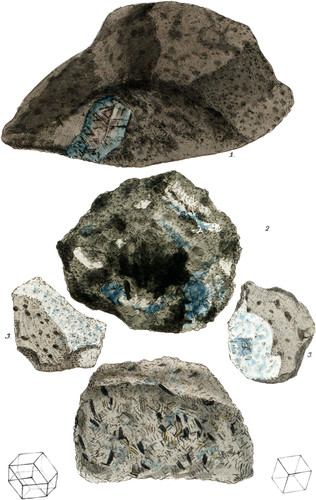 Enlarge
Enlarge
Exotic Mineralogy
Hauyne
- Syn.
- Haüne. Neergaard Journal des Mines, No. 125, p. 365. Bournon Catal. 47. Aikin, 215.
- Latialite. Gismondi. Haüy Tabl. 62.
- Saphirin. Nose.
This rare mineral is described as occurring in rhomboidal dodecahedrons, but I have not been able to meet with a specimen in which I could discover a single regular crystal. It generally assumes the form of rounded grains dispersed through the gangue: sometimes the grains are; collected into small masses, and of these masses some parts are very pale blue, or even white, while other parts retain the blue colour in all its beauty. The variety among dark brownish-green Mica, accompanied by Meïonite, &c. generally exhibits this arrangement. The variety from near Rome is generally composed of more or less insulated grains imbedded in a cellular stone, by some called Basalt, but which has much more the appearance of volcanic Scoria. The specimen I have figured of this, contains a large grain, or rather nodule, of a dull pale violet colour near the surface, and lilac in the centre: it has fortunately been broken through so as to exhibit not merely its foliated structure, but the position of its laminaæ parallel to three sides of an obtuse rhomb: there are also sufficient indications of laminæ intersecting these, to prove that the nucleus is a dodecahedron with rhomboidal faces similar to that of Garnet.
Haüyne is equal in hardness to Quartz: the spec. grav. is from 3.100 to 3.333: it remains unchanged in colour, and is not melted by the action of the blow-pipe. Nitric acid allowed to remain upon its powder changes it into a white transparent jelly. The analysis by Vauquelin gave the following constituent parts:
| Silex | 30. |
| Argilla | 15. |
| Lime | 5. |
| Potash | 11. |
| Oxide of Iron | 1. |
| Sulphate of Lime | 20.5 |
| Sulphureted hydrogen, a trace | |
| Loss | 17.5 |
| 100.0 |
We should not think the name a compliment to the penetrating crystallographer Haüy, did not the scarcity of the substance in some measure represent the rare occurrence of such a comprehensive genius.
Fig. 1 a specimen from mar Rome.
Fig. 2 the variety from the neighbourhood of Vesuvius, in amass of Mica, with Meibnite, Epidote, &c.: this is in the cabinet of G. B. Greenough, Esq.
Fig. 3 from Albano, mixed with a white substance, probably Feldspar, in Basalt, containing Augite and Mica.
Fig. 4, from the Laager See, in a mass composed of transparent grey crystals of Feldspar, with Augite and yellow Sphere. I am under obligations to Proff. Strömeyer for the specimens from which these two last figures are taken.
The geometrical figures shew the rhomb as displayed in fig. 1 and the dodecahedron resulting from a combination of all its fractures.

